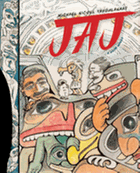
Internationally renowned artist, author, and activist Michael Nicoll Yahgulanaas began melding traditional North Pacific Indigenous iconography and modern Asian artistic influences in the late 1990s to create "Haida manga," introduced in his award-winning Red (2009). In JAJ, Yahgulanaas returns with his spectacular hybrid artistry to brilliantly interrogate first contact between Europeans and the Indigenous people of his ancestral home, western Canada's Haida Gwaii archipelago. JAJ, the opening page reveals, has two meanings: "(1) one who decides (Hindi), (2) Johan Adrian Jacobsen." Both are haunting references: the deciders are invading Europeans, among them adventurer and ethnographer Jacobsen. The initial European arrivals to the islands were "in need of rescuing"; their "brief time together was filled with common purpose. And with friendship." The island populations thrived, creating "sophisticated structures for mariculture, agriculture, aquaculture... all kinds of culture." But with outside discovery, peace didn't last: "Then the others came... hungry, disrespectful, and illegal by any law." Smallpox followed, decimating indigenous communities. Woven through the violent colonial history is Jacobsen's personal journey that leads him to his arrival at Haida Gwaii with his "shopping list from Berlin" for Indigenous treasures.
Like Red, the phenomenal pages of JAJ can be deconstructed and reassembled into a large single image, without the narrative text. The original mural was commissioned in 2021 by Berlin's Humboldt Forum where, incredibly, the totem pole Jacobsen carried back to Europe is also displayed; the Forum's predecessor institution, Berliner Museum für Völkerkunde, sent Jacobsen to Haida Gwaii in the 1880s. Utterly remarkable is the confluence of history, family ancestry, fine art, inventive bookmaking--all available to witness here in Yahgulanaas's unforgettable gift of Haida Manga. --Terry Hong, BookDragon

